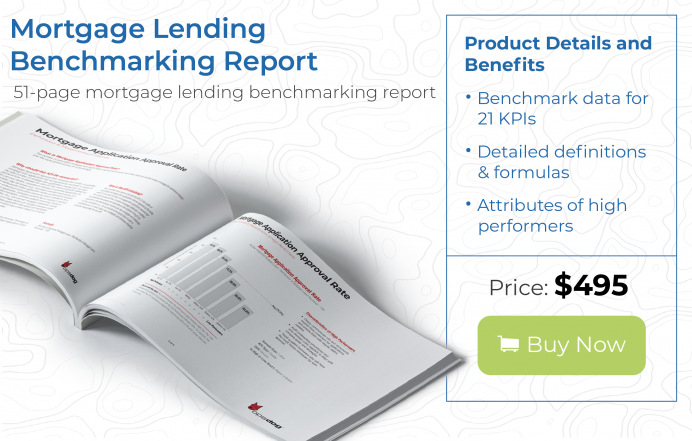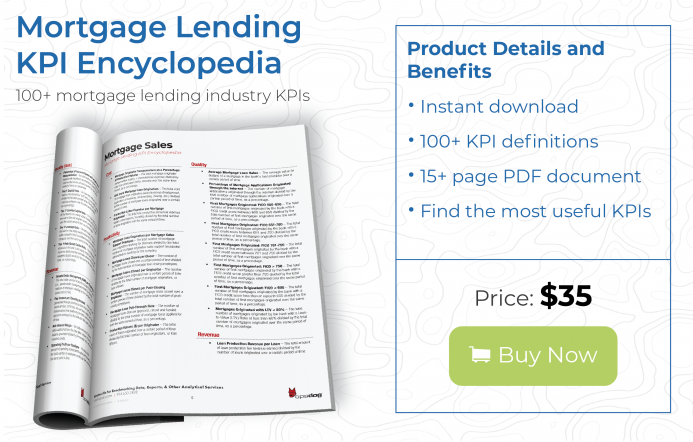The launch of Rocket Mortgage from Quicken Loans put traditional mortgage lenders on notice: If you want to compete, you better provide borrowers with faster lending decisions and a streamlined application process. As a result, lenders are feeling the pressure to improve the borrower experience.
One of the best ways to do just that is to dive into the world of mortgage loan officer key performance metrics. Learning how to harness the power behind key performance indicators (KPIs) can build stronger mortgage loan officers that in turn provide a better borrower experience.
What are Mortgage Loan Officer Performance Metrics?
Lenders have plenty of competition in the home loan market—from both traditional banks and digital-only lenders. But, the loan products themselves have become largely commoditized.
In a world in which loan products all look alike, one of the only things that you can compete on is the loan origination experience. Mortgage loan officers are the bridge between the borrower and the lender and the efficiency and productivity of these mortgage professionals is key to a lender’s success.
Loan officers, sometimes called loan originators, are responsible for attracting and developing new business, keeping borrowers informed, and helping borrowers navigate the loan origination process. Although an increasing number of your mortgage loan applications are likely digital, loan officers still play a crucial role in how a borrower perceives your institution and their overall satisfaction.
Lenders also want loan origination to be easier and faster since an easier process for borrowers translates into higher and faster close rates, lower abandonment, and higher throughput from their team of loan officers. Here is where mortgage loan officer key performance metrics can help.
How to Use Mortgage Performance Metrics to Boost Borrower Experience
Mortgage loan officer key performance indicators (KPIs) can be defined as metrics such as how many loans you can close and the average amount of time to close can highlight issues such as poor communication between loan officers and borrowers about the documents needed, a confusing or hard-to-complete loan application, or a lack of automation with too many manual touchpoints. KPIs track this data and provide a baseline to grow from.
For borrowers, the mortgage process is stressful. They have to provide multiple documents worry that the loan terms are competitive, or worry the underwriter will deny the loan. They can be confused about the actual process. Anything that complicates the process for borrowers increases the likelihood that they’ll jump ship to another lender.
Mortgage loan officers can lower borrower stress—but they need time to work with borrowers. Unfortunately, too much of loan officer time is spent on low-value tasks such as collecting loan documents, processing applications, and setting appointments.
Loan officers are also responsible for bringing new business. Streamlining the loan origination process frees loan officers to work on high-value tasks including prospecting and lead generation.
Mortgage Loan Officer Performance Metric Examples
No amount of marketing will make up for inefficient mortgage loan officers who are not good at business development and closing loans. Getting a handle on loan officer performance will increase revenue from origination and closing fees, improve the borrower experience, and allow you to compete in a commoditized market.
Here are five commonly used mortgage loan officer performance metrics:
Mortgage Loan Officer Metric #1: Mortgages Closed Per Loan Officer
Loan officers that work for lenders with standardized processes for lead generation and prospecting and that spend time proactively communicating with potential borrowers tend to close the most loans. While more loans closed is better, balance the quantity of loans with quality. Closing a lot of mortgages that are for low amounts or too risky borrowers negates the advantages of a high number of loans closed.
To calculate, divide the total number of closed mortgage loans by the average number of mortgage loan officers or originators. Include only fully funded loans.
Mortgage Loan Officer Metric #2: Mortgage Loan Auto-Decision Rate
Automated underwriting can speed loan approvals, shorten cycle times, provide consistency in lending decision-making, and save lenders money. Offloading as many mortgage applications to automatic underwriting frees underwriters to focus on more complex loans. And faster lending decisions are a boom to anxious borrowers.
To calculate, divide the number of automatically underwritten mortgage loan applications by the number of loan applications submitted, as a percentage.
Mortgage Loan Officer Metric #3: Mortgage Closing Cycle Time
Perhaps nothing frustrates borrowers more than mortgage loans that “go down to the wire” replete with last-minute requests for additional documents. In addition to a poor borrower experience, long closing cycle times impact your operational efficiency. It’s critical to communicate with borrowers exactly what they need to do and where the loan is in the underwriting process.
To calculate, divide the sum of time to close by the total number of closed and funded mortgages. The sum of time to close is the number of business and non-business days between the application date and the close date. Include only new mortgages and refinances but consider analyzing each type of loan separately since new mortgages typically take longer to close than refinances.
Mortgage Loan Officer Metric #4: Mortgage Application Approval Rate
It’s a waste of resources to receive a large percentage of mortgage applications from unqualified borrowers. You want to only target qualified borrowers who have the right credit history. Also, ensure that you communicate approval status updates with applicants so they don’t get frustrated and look for their funding elsewhere.
To calculate divide the number of approved mortgage applications by the total number of mortgage loans received, as a percentage. Include both digital and in-person applications. Include only new mortgages and refinances but consider analyzing new mortgages and refinances separately since the approval rate may be different for each type of loan.
Mortgage Loan Officer Metric #5: Percentage of Mortgage Loans Abandoned by Borrower
You can lose borrowers at any point during the origination process. Maybe they found better loan terms at your competitor. Maybe you took too long to schedule a closing. Or maybe your lending officer wasn’t clear about where the loan was in the pipeline. Regardless of the reason, any loan that you’ve approved and doesn’t close means lost revenue.
To calculate, divide the number of rejected or withdrawn applications from borrowers by the number of approved applications. Include both digital and in-person applications. Include only new mortgages and refinances but consider analyzing new mortgages and refinances separately since the abandonment rate may be different for each type of loan
Final Thoughts
Mortgage lending is competitive—and there is no end in sight. Mortgage loan officers that are adept at following-up on leads, uncovering new business opportunities, and can educate borrowers through the lending process have a direct impact on lender profitability.
For a full list of mortgage loan metrics and other related lending performance metrics, download our Mortgage Lending Key Performance Indicator Encyclopedia here.
If you require additional assistance in developing lending metrics to use in benchmarking, then you may find our Mortgage Lending Benchmarking Report helpful. For even more information on our Benchmarking Research and business intelligence implementation services, contact us here. OpsDog can help your insurance company build a benchmark plan and provide you with presentation-ready, high-quality deliverables.




